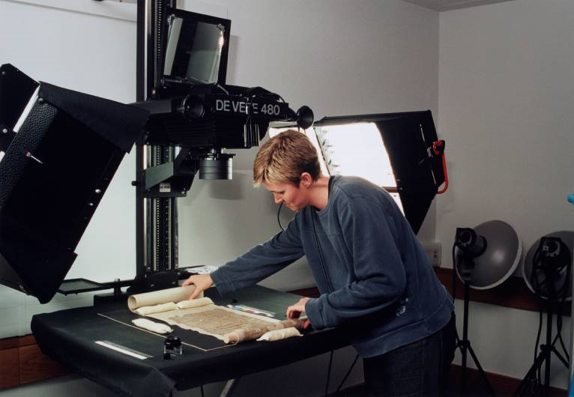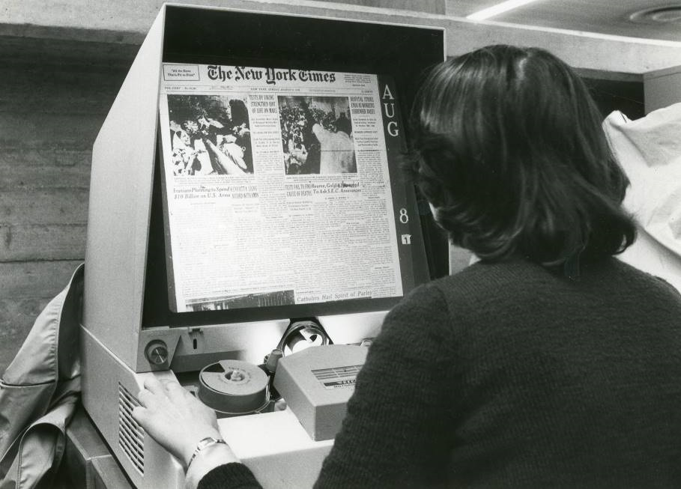Collection reproduction for preservation
Prepared by PAC North America
Q: What is collection reproduction?
Collection reproduction, also known as reformatting, uses standardized photographic reproduction techniques to create a facsimile of a collection item. Most collection reproduction at present is through digital means, and is called digitization or digitalization.
- Reformatted surrogates provide patrons access to a given item’s intellectual content without handling the physical item, a risk which may expose it to further damage.
- Collection reproduction is also a common collection management method to conserve shelf space, especially for high-volume publications such as newspapers. Digital and microform objects require significantly lower storage expenditures than the physical original, allowing collection managers to send reformatted physical items offsite or withdraw them from the collection without significantly limiting access.
- Collection reproduction can take place in-house with internal employees using institutionally owned equipment or external vendors can provide reformatting services on a contract basis.
- A collection reproduction program works most effectively when it collaborates openly with collection care specialists and collection management specialists. Items often require treatment prior to reformatting, and will often require enclosures to stabilize the item for offsite storage following the reformatting process.
- Planning and implementing a collection reproduction program further depends on an awareness of institutional needs and capabilities. Administering discrete reformatting projects is possible with vendor support and grant funding, while larger organizations with extensive collections may require large, annually renewing contracts and/or an established in-house program to manage many concurrent work streams.
IFLA. Digital Library Futures: User perspectives and institutional strategies.
IFLA/UNESCO. Manifesto for digital libraries.
Q: How do I select candidates for collection reproduction?
Formalizing a reformatting workflow in a written policy provides a standardized selection process by which curators, collection managers, preservation officers, and other digital collection development stakeholders can have input in the proposal and selection process. An institution seeking to develop a permanent reformatting program would benefit significantly from a formalized workflow. The following are effective starting points for selection:
- Focus reformatting resources on items with the highest preservation needs and items that will benefit patrons the most. This is often determined based on item use data.
- Prioritize reformatting collection items that best fit within your institutions mission statement and collection scope.
- Collections can benefit from reformatting items in danger of loss due to rapid degradation, such as brittle books, newspapers, and periodicals printed on ephemeral wood pulp paper.
- Frequently requested items or rare items are additional areas of concern, especially where the condition, materials, and/or shape of the items make them fragile to handle. Collection reproduction can ensure that items that ought not to be handled by patrons can have alternative access methods, and that the intellectual content of such items are preserved even if the physical item must be withdrawn.
- Collection inventories and condition assessments, including random sample surveys, are a data-oriented way to identify problem areas in collections, aiding the selection process.
- In addition, organize your efforts toward items of the same physical type and size (e.g. a collection of similarly sized photographs or bound volumes).
- As digital reformatting programs mature, many institutions choose to establish systematic ways in which patrons can contribute to the selection process by nominating items through a “scan-on-demand” workflow. Scan-on-demand programs are effective to contribute to both preservation and access missions when implemented in tandem with other selection criteria. In some cases, institutions choose to use scan-on-demand programs as a means of cost recovery.
- Always review rights concerns before selecting an item for reformatting, including reviewing the item’s copyright status.
Q: What are the major collection reproduction methods and media?
- Digital reformatting has quickly risen to become the most common means of reproduction due to its access benefits and the advantages of optical character recognition software. In most institutions, reformatting programs are entirely digital scanning.
- One of the most common reformatting methods of the past century was microform, including microfiche (flat sheets of film images) and the more common microfilm (rolls of film images), each of which requires magnification equipment for access.
- Today, institutions with large collections of microfilm are digitizing microfilm frames for elevated access.
- If copyright restricts the public electronic presentation of digital facsimiles, contractors can print physical preservation photocopies to keep as service copies. Effective preservation photocopying adheres to preservation standards, such as the use of non-acidic materials and high-quality binding, to be an effective means of collection reproduction
- Even though microfilm is in the decline, many institutions maintain large-scale microfilming operations into the 2020s. Proponents argue that it is often cheaper to produce and maintain microfilm. Although microfilm is notably less accessible to patrons than digitally reformatted works, many institutions continue to use it as a preservation and space-saving strategy, given that a properly stored roll of microfilm can survive for more than 500 years. See the FAQ “Should I microfilm items?” below.
Q: How do I set up a digital reformatting program?
Funding: Many grant opportunities exist for cultural heritage digital reformatting projects for numerous sizes and types of institutions. Notifications of Funding Opportunities appear annually from government institutions and nongovernmental organizations, often with the aim of promoting projects aimed at reformatting collections relevant to national or cultural identities.
Administration: Contracting reformatting work to external vendors can be effective for discrete reformatting projects. When reformatting goals extend beyond a few collections to many sustained work streams, an in-house reformatting program or a combination of in-house and vendor operations may be ideal. Even a fully vendor-led reformatting program will require devoting in-house staff time to maintaining the contract and performing quality control for projects.
Technical specifications: Consult relevant technical guidelines for benchmarks when performing quality control or planning a scanning project. General technical guidelines for technical guidelines can be found in IFLA’s “Guidelines for digital projects” (p. 17). Technical documentation such as the US Federal Agencies Digital Guidelines Initiative (FADGI) or the Dutch Metamorfoze guidelines are examples of authoritative resources (see list of resources below).
Metadata: Metadata needs vary by institution and project, but you must plan to capture beyond simply descriptive metadata. Additional types of potentially relevant metadata include administrative, rights, technical, structural, and preservation metadata, among others. FADGI guidelines are a reference point for planning the types and granularity of metadata capture necessary.
Access and preservation: See additional FAQs addressing access and preservation needs for digital surrogates.

Q: How do I present digital surrogates?
Despite digital reformatting’s effectiveness as a preservation and access strategy, digital assets are useless if they are inaccessible. Securely presenting digital surrogates to patrons requires careful consideration of license agreements and copyright law.
- One of the most important aspects of managing digital content is the digital repository. Many large organizations develop and manage their own institutional repositories, such as Gallica, the national digital library of France, or Sedici, the institutional repository of the National University of La Plata. Those with fewer resources or smaller scaled collections, however, may participate in alternatively administered repositories. These options include nonprofit open access repositories, such as Indonesia’s Neliti, or the United States’ Internet Archive and HathiTrust, as well as consortial repositories such as the Digital Archive of the Georgian Library Association and Calisphere.
- Planning for OCR implementation is a major part of making scanned images function as full-text documents for scholarly use. OCR requires specialized software and familiarity with text encoding to implement.
- Copyright is a major consideration when choosing what to present and how. For an expanded perspective on copyright issues in several countries see the World Intellectual Property Organization’s “Study on copyright limitations and exceptions for libraries and archives” (p. 50). Carefully consult your country’s copyright code (usually available on the website of your government’s copyright office) to ensure institutional policy does not run afoul. Works published in the United States more than 95 years ago, for example, are in the public domain and the law permits open access on any website. Additionally, archival holdings may have specific reformatting and presentation guidelines stipulated in the donor agreement.
- In some cases, institutions choose to present rights-restricted material using internally developed web-based platforms that permit only on-site access.
Q: How do I preserve digital surrogates?
Establishing an infrastructure and workflows that support digital reformatting does not end with purchasing scanning equipment, hiring technicians, or finding a scanning vendor. Digital preservation is a significant and necessary cost of building a digital collection. The most important issues include:
- Implementing quality review of digital surrogates.
- Identifying or purchasing data storage spaces.
- Identifying or building a preservation repository, including identifying and implementing software to manage digital assets.
- Developing a digital preservation workflow that ensures multiple properly packaged copies, including an archival master image, a production master image, and an access image for each frame.
- Identifying benchmark file sizes, file types, and compression.
- Developing naming conventions for all digital assets.
- Ensuring preservation, technical, and structural metadata are properly captured. This includes tracking information about the makeup of your digital assets, where they are stored, and how they are stored. Metadata such as checksums ensure that your files do not undergo unexpected change or corruption.
Q: Can I digitally reformat items under copyright?
Each country governs copyright differently. Complicating matters, each country enforces other countries’ copyright laws differently. Items published in your own country that are in the public domain according to your country’s copyright laws are the safest candidates for reformatting and online presentation. Beyond these works, it is ideal to consult a lawyer when formulating reformatting policy.
Other rights restrictions aside from copyright may limit your institution’s ability to digitally reformat, or limit digital surrogates’ presentation to patrons. Donated materials, for example, may stipulate reformatting or access permissions in the donor agreement, especially in the case of archival materials in general or personal papers in particular.
If agreements between donors and your institution are unclear on the question of reformatting, it is ideal to consult a lawyer before embarking on an archival reformatting project.
Q: Should I microfilm items?
While microform programs are rarely preferred over digital reformatting today, some institutions continue to advocate for microfilming. Microfilm may be a viable option if:
- Your institution’s primary goal is preservation of the items’ intellectual content.
- Expected access to reformatted collections is likely to be infrequent.
- The project in question encompasses a large quantity of items at risk for degradation, such as newspapers.
- The items in question are in the public domain.
- Shelf space is limited.
- Resources for digital preservation are limited.
- Your institution is equipped to maintain a proper storage environment for microfilm.

More information
Download the PDF for a list of additional resources and links.